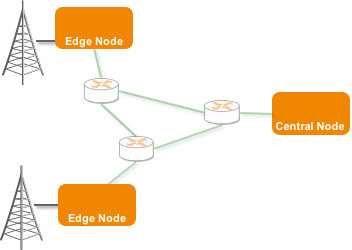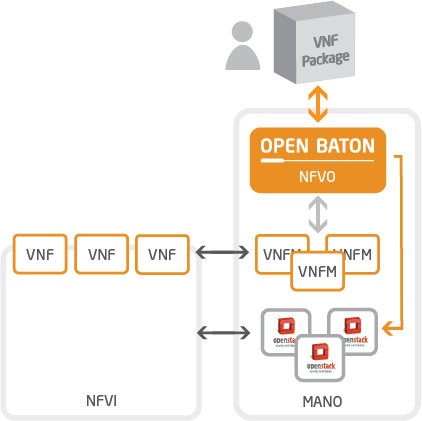MEC Enablement by Means of an Open Source ETSI MANO Orchestrator
Giuseppe Antonio Carella and Prof. Dr. Thomas Magedanz, Technische Universität Berlin, Fraunhofer FOKUS
With the still growing number of mobile Internet users and the, albeit being not as fast, growing number of mobile Internet devices per person, the Next Generation Network (NGN) infrastructures will be increasingly challenged in the upcoming years. For reducing the impacts of such growing traffic, Network Function Virtualization (NFV) and 5G trends are towards deploying software-based Network Functions on a heterogeneous infrastructure composed by a very large number of datacenters, able to dynamically cope with situation of peak loads.
As envisioned by the NGNM white paper [1], 5G will have to deal with many different requirements coming from different domains, therefore the dynamicity, and in particular the flexibility, are key enablers for rapid innovation. Furthermore, this rapid deployment of datacenters is paving the way towards a different type of environment in which the computational resources are deployed up to the edge of the network. ETSI Mobile Edge Computing (MEC) [2] envisions the idea of offering cloud computing capabilities to service providers and application developers at the edge.
Figure 1. Mobile Edge Computing deployment architecture
With MEC in place, it will be possible to deploy services and applications closer to the users/devices, allowing the reduction of data volumes exchange and latency, with enhancements to the Quality of Service perceived by the end users.
However, the current standardization bodies don’t have concrete solutions yet, and due to the large number of working items, it is quite complex to align and agree upon a single architecture. The ETSI NFV [2] group proposes a multi-site NFV Infrastructure (NFVI) where different Point of Presences provide cloud capabilities for hosting Virtual Network Functions (VNFs). While, the ETSI MEC [3] group proposes an architecture for the edge nodes, which are integrated as NFVI PoPs in the ETSI NFV architecture. However, at this stage, it is pretty complex to foresee a clear definition of the interfaces and protocols which could make this possible.
The early prototyping of new concepts and architectures, is probably the key for building successful standards, and, at the moment, it represents the only certainty in such fragmented environment. Open Source (OS) software and toolkits have proven in the past to be of great value in the next generation networks and future internet context and thus are considered key for understanding and mastering the challenges of the complex emerging 5G environment.
In particular, Fraunhofer FOKUS and TU Berlin have been working since many years integrating OS solutions together with industry and academia, in their so called “testbeds to go”. Their OS toolkits, like the Sip Express Router (SER) and the Open IP Multimedia Subystem (IMS) Core, have been catalysts for understanding the technical challenges and developing corresponding standards in the VoIP and NGN domains and have been the foundation for creating technology innovation labs around the globe. Some good examples of such labs are the IMS [4] and the FUSECO Playground [5].
By exploiting their long-term expertise in analyzing Next Generation Network (NGN) Infrastructures and implementing versatile tools, they launched a new open source platform, Open Baton [6][7], providing the means for building a complete NFV environment based on the ETSI MANO [8] specification.
Figure 2. Open Baton Architecture
Open Baton provides a NFVO for managing Network Services, a generic VNFM supporting the execution of lifecycle events provided in the VNF Descriptors, and a lightweight Element Management System (EMS) instantiated on demand for executing lifecycle events on the deployed resources. Open Baton allows the instantiation of any kind of Network Service. It follows the ETSI MANO v1.1.1 [8] specification and provides a catalogue of VNFs which can be composed together in a Network Service and deployed on a multi site NFVI. One of the key features of the NFVO is the capability of controlling multiple types of Virtual Infrastructure Managers dislocated on different locations providing the means for initial prototypes of on demand deployment of VNFs on the edge of the network. It interacts with OpenStack via a driver mechanism, which can be easily extended for supporting other lightweight MEC technologies, like Docker [9] or Kubernetes [10], which may be required on those PoPs for reducing operational costs.
The objective is to share the gained experiences enabling researchers around the globe to build their own 5G/SDN/NFV/MEC testbeds, as well as to create the needed knowhow for emerging 5G standards with initial Proof of Concepts (PoC) in this domain. However, Open Baton represents just one of the key components of those NGN Architectures, and there is a need of building a full ecosystem which can demonstrate the feasibility of key features for future networks. Typically Fraunhofer FOKUS and TU Berlin are developing “OpenXXX” toolkits which can be combined together for building a comprehensive testing environment. These assets will be contributed to the newly created IEEE SDN Work Group “Open Source SDN/NFV/MEC Toolkits & Testbeds Work Group”, in which one of the aim is to setup a repository of useful open source toolkits, and an international community of dedicated experts around them, to share their experiences on useful combinations of these toolkits for realising different PoCs. Another example of state of the art 5G testbed is the FOKUS 5G Playground [11] combining both Open Source toolkits and closed source toolkits / pre-products developed by Fraunhofer FOKUS and TU Berlin as part of their strong collaboration, which is also part of the 5G Berlin initiative [12] where Fraunhofer FOKUS and Fraunhofer HHI are collaborating together for building a comprehensive 5G ecosystem, as a single stop-shop for Radio and Core R&D.
References
[1] NGNM White Paper, online https://www.ngmn.org/uploads/media/NGMN_5G_White_Paper_V1_0.pdf
[2] ETSI NFV Architectural Framework v1.2.1 (2014-12), online http://www.etsi.org/deliver/etsi_gs/NFV/001_099/002/01.02.01_60/gs_NFV002v010201p.pdf
[3] ETSI Mobile Edge Computing, online http://www.etsi.org/technologies-clusters/technologies/mobile-edge-computing
[4] Magedanz, T.; Witaszek, D.; Knuettel, K., "The IMS playground @ FOKUS-an open testbed for generation network multimedia services," in Testbeds and Research Infrastructures for the Development of Networks and Communities, 2005. Tridentcom 2005. First International Conference on , vol., no., pp.2-11, 23-25 Feb. 2005
[5] FUSECO Playground , online https://www.fokus.fraunhofer.de/go/en/fokus_testbeds/fuseco_playground
[6] Open Baton: an open source Network Function Virtualisation Orchestrator (NFVO)
fully compliant with the ETSI NFV MANO specification, online http://openbaton.org
[7] Open Baton video, online https://www.youtube.com/watch?v=e9VbeRohjJ8&feature=youtu.be
[8] ETSI GS NFV-MAN 001 (MANO), online https://www.etsi.org/deliver/etsi_gs/NFV-MAN/001_099/001/01.01.01_60/gs_NFV-MAN001v010101p.pdf
[9] Docker, online docker.com
[10] Kubernetes, online kubernetes.io
[11] 5G Playground, online https://www.fokus.fraunhofer.de/go/en/fokus_testbeds/5g_playground
[12] 5G Berlin initiative, online www.5g-berlin.org
 Thomas Magedanz is a professor in the electrical engineering and computer sciences faculty at the Technical University of Berlin, Germany, leading the chair for next
generation networks (Architektur der Vermittlungsknoten / AV) and director of the 'NGNI' division at the Fraunhofer Institute FOKUS, which provides toolkits and open experimental platforms for fixed and mobile Next Generation Networks.
Thomas Magedanz is a professor in the electrical engineering and computer sciences faculty at the Technical University of Berlin, Germany, leading the chair for next
generation networks (Architektur der Vermittlungsknoten / AV) and director of the 'NGNI' division at the Fraunhofer Institute FOKUS, which provides toolkits and open experimental platforms for fixed and mobile Next Generation Networks.
More details: http://www.av.tu-berlin.de/menue/team/prof_dr_thomas_magedanz/
 Giuseppe Antonio Carella is a Senior Researcher at the Fraunhofer FOKUS and at the Technische Universität Berlin (TUB). He received his M.Sc. in Engineering of Computer Science from the Alma Mater Studiorum University of Bologna in 2011. He is currently leading the team developing the Open Baton toolkit, an open source platform providing the means for building a comprehensive NFV environment.
Giuseppe Antonio Carella is a Senior Researcher at the Fraunhofer FOKUS and at the Technische Universität Berlin (TUB). He received his M.Sc. in Engineering of Computer Science from the Alma Mater Studiorum University of Bologna in 2011. He is currently leading the team developing the Open Baton toolkit, an open source platform providing the means for building a comprehensive NFV environment.
More details: http://www.av.tu-berlin.de/carella
Editor:
 Marie-Paule Odini is a seasoned HPE executive, bring over 25 years of telecom experience. She has deep expertise in both the networking and IT environments, NFV, SDN and M2M/IoT.
Marie-Paule Odini is a seasoned HPE executive, bring over 25 years of telecom experience. She has deep expertise in both the networking and IT environments, NFV, SDN and M2M/IoT.
Marie-Paule is Distinguished Technologist for CMS, Communication and Media Solution organization, focused on customer innovation and emerging trends in the communication industry. She leads the technology discussions for NFV (Network Function Virtualization), M2M, Analytics, Cloud. She seats on ETSI, ATIS, IEEE and other standard bodies. She is Vice-chairman of ETSI NFV ISG, seats on the Technical Steering Committee, is a Vice Chair of TST working group (testing, interoperability and Opensource), rapporteur of SDN work item, and Vice Chair in IEEE SDN. She participates in European Commission SDN-NFV task force, and is also active on M2M & IoT, within ETSI and OneM2M, rapporteur of TG28 low throughput network work items, working with new players such as Sigfox or LORA technologies. She holds a few patents and is also a frequent industry speaker and editor in professional magazines and blogs, incl HPE Telecom IQ.
Marie-Paule prior responsibilities include managing HP’s worldwide VoIP program, HP’s wireless LAN program, and HP’s Service Delivery program. Since joining HP in 1987, she has held positions in technical consulting, sales development and marketing in Europe and in the Americas. Those roles have focused on strategic and operational responsibility for Networking, IT and operations in the telecom domain.
Marie-Paule holds a master’s degree in Electrical Engineering from Utah State University and business education from INSEAD, Paris. Prior to joining HP, Marie-Paule spent five years with France-Telecom/Orange research and development labs, defining architecture and value-added services launch for corporate customers. She enjoys skiing and outdoors in general.
Subscribe to IEEE Softwarization
Join our free SDN Technical Community and receive IEEE Softwarization.
Article Contributions Welcomed
Download IEEE Softwarization Editorial Guidelines for Authors (PDF, 122 KB)
If you wish to have an article considered for publication, please contact the Managing Editor at sdn-editor@ieee.org.
Past Issues
IEEE Softwarization Editorial Board
Laurent Ciavaglia, Editor-in-Chief
Mohamed Faten Zhani, Managing Editor
TBD, Deputy Managing Editor
Syed Hassan Ahmed
Dr. J. Amudhavel
Francesco Benedetto
Korhan Cengiz
Noel Crespi
Neil Davies
Eliezer Dekel
Eileen Healy
Chris Hrivnak
Atta ur Rehman Khan
Marie-Paule Odini
Shashikant Patil
Kostas Pentikousis
Luca Prete
Muhammad Maaz Rehan
Mubashir Rehmani
Stefano Salsano
Elio Salvadori
Nadir Shah
Alexandros Stavdas
Jose Verger





